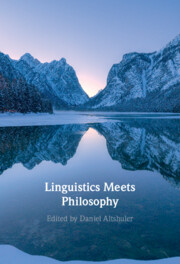Book contents
- Linguistics Meets Philosophy
- Linguistics Meets Philosophy
- Copyright page
- Contents
- Figures
- Tables
- Contributors
- Linguistics Meets Philosophy: A Historical Preface
- Introduction
- Part I Reporting and Ascribing
- Part II Describing and Referring
- Part III Narrating and Structuring
- Part IV Locating and Inferring
- 7 Present Tense
- 8 Evidentiality: Unifying Nominal and Propositional Domains
- Part V Typologizing and Ontologizing
- Part VI Determining and Questioning
- Part VII Arguing and Rejecting
- Part VIII Implying and (Pre)supposing
- Index
- References
8 - Evidentiality: Unifying Nominal and Propositional Domains
from Part IV - Locating and Inferring
Published online by Cambridge University Press: 06 October 2022
- Linguistics Meets Philosophy
- Linguistics Meets Philosophy
- Copyright page
- Contents
- Figures
- Tables
- Contributors
- Linguistics Meets Philosophy: A Historical Preface
- Introduction
- Part I Reporting and Ascribing
- Part II Describing and Referring
- Part III Narrating and Structuring
- Part IV Locating and Inferring
- 7 Present Tense
- 8 Evidentiality: Unifying Nominal and Propositional Domains
- Part V Typologizing and Ontologizing
- Part VI Determining and Questioning
- Part VII Arguing and Rejecting
- Part VIII Implying and (Pre)supposing
- Index
- References
Summary
In the vast literature on evidentiality, empirical and theoretical focus has mostly been on propositional evidentiality, i.e. evidentials that scope over propositions. In this work, we undertake a crosslinguistic comparative study of propositional and nominal evidentiality, i.e. evidentials that scope over nominals, and are fused with the determiner/demonstrative systems or with nominal tense markers. I demonstrate that there are cohesive parallels in how flavors of both propositional and nonpropositional evidentiality interact with verbal and nominal tense and aspect. I use tools from modal logic to show that we can (i) unify the subdomains of evidentiality using modal accessibility relations while also preserving important distinctions between them, (ii) use the same tools to compositionally capture the interaction between evidentials and tense and aspect, and (iii) have the representation of an agent’s certainty of belief be reflected in quantificational force. Concretely, directly encoding the subtype of evidence in the semantics, I argue that three distinct evidential flavors embody three distinct spatio-temporal modal accessibility relations: direct (sensory) evidentials are temporally-sensitive historical necessity relations (yielding the factive nature of perception); inferential evidentials of pure reasoning are epistemic accessibility relations; inferential evidentials of results are a combination of the above two.
Keywords
- Type
- Chapter
- Information
- Linguistics Meets Philosophy , pp. 243 - 274Publisher: Cambridge University PressPrint publication year: 2022
References
- 1
- Cited by



